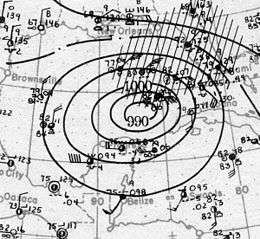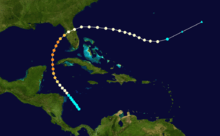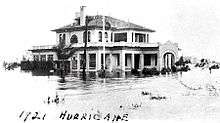1921 Tampa Bay hurricane
| Category 4 major hurricane (SSHWS/NWS) | |
 The hurricane on October 24, several hours after peak intensity | |
| Formed | October 20, 1921 |
|---|---|
| Dissipated | October 30, 1921 |
| Highest winds |
1-minute sustained: 140 mph (220 km/h) |
| Lowest pressure | ≤ 941 mbar (hPa); 27.79 inHg |
| Fatalities | 3-8 direct |
| Damage | $10 million (1921 USD) |
| Areas affected | Western Caribbean, Cuba, Florida Keys, Florida Peninsula |
| Part of the 1921 Atlantic hurricane season | |
The Tampa Bay hurricane of 1921 (also known as the 1921 Tarpon Springs hurricane) was the third hurricane, second major hurricane, and final storm of an inactive 1921 Atlantic hurricane season. The storm took a typical path for an October Atlantic hurricane, brushing past Cuba before hitting near Tampa, Florida, becoming the first major hurricane to hit the area since the hurricane of 1848. The hurricane was also the most destructive storm of the season, causing around $10 million (1921 USD), $92 million (2005 USD) in damage. It is the last major hurricane to strike the Tampa Bay area to date.
Meteorological history

The storm was observed on October 20 while several hundred miles southwest of Jamaica. Its origin is unknown, though it possibly developed from a low pressure area over Panama a day earlier.[1] A high pressure system over Bermuda caused a north-northwest motion, allowing for the storm to intensify over favorable conditions. On October 22, the storm attained hurricane status shortly after passing 10 miles (16 km) east of the Swan Islands. On October 23, the hurricane attained a peak intensity of 140 miles per hour (230 km/h), with a central pressure of at most 27.80 inches of mercury (941.42 mb), as it entered the Yucatán Channel, with its eastern side brushing the western end of Cuba.[2]
As it turned to the north in the Gulf of Mexico, the hurricane maintained its intensity before curving to the north-northeast on October 24. Thereafter, it turned northeast and quickly weakened, making landfall as a Category 3 hurricane near Tarpon Springs, Florida, on October 25 with sustained winds of 115 mph (185 km/h) and a central pressure of 958 mb (28.29 inHg).[3] The hurricane quickly crossed Central Florida before entering the Atlantic, weakening to a minimal hurricane over land. It accelerated to the southeast before recurving to the east-northeast. It transformed into an extratropical cyclone on October 30 while centered southeast of Bermuda.[2]
Preparations
Forecasters at the United States Weather Bureau issued advisories for ships and oceangoing vessels and hurricane warnings for areas in western Florida stretching from Key West to Apalachicola on October 24 and 25.[1]
Impact
In Cuba, heavy rainfall in Pinar del Río Province caused rivers and creeks to rise. However, only minimal damage was reported.[4]
The hurricane passed to the west of the Florida Keys as a Category 4 hurricane. Its large wind field caused tropical storm force winds to the islands, with the highest wind report being 48 mph (71 km/h) in Key West. Rainfall from the hurricane's outer bands was intermittent, and storm tides of 5 ft (1.5 meters) were reported.[1] The streets of Punta Gorda were inundated, where a tide of 7 ft (2.1 m) above normal was recorded. Egmont Key and Sanibel Island were both "practically covered by water."
The hurricane brought a storm surge of 10–12 ft (3 to 3.5 m) to Tampa Bay.[5] The highest rainfall total in Tampa was at 8.53 in (23.5 mm).[1] However, the observer noted that winds probably blew water out of the gauge. The barometric pressure fell to 968 mbar (28.6 inHg), breaking a previous record set in 1910. The hurricane also brought sustained winds of 75 mph (119 km/h) and a storm tide of 10.5 ft (3 m).[1] Damage from the wind was generally minor, while most of the impact wrought by the storm was due to abnormally high tides in Tampa and elsewhere in the area. Much of the city was flooded,[5] with the worst along Bayshore Boulevard, where some of the most expensive properties were located. At Hyde Park, dwellings were inundated about halfway up the first story, prompting several people to be rescued by boat. Electrical poles and wires were washed away near the intersection of Bayshore Boulevard and Howard Avenue. The latter was also left impassible by car.[6]

At Ballast Point, the pavilion and bathhouse were destroyed by the storm.[7] Nearby, the Tampa Yacht and Country Club suffered severe damage.[5] Many cars along the waterfront were severely damaged and nearly all flat railroad cars were submerged. The Malloy Line dock was also left under several feet of water. A number of waterfront warehouses were also damaged by floodwaters. After the Tampa Electrical Company power house experienced water damage, the electricity was shutoff. Additionally, the company's cable station was flooded under several feet of water. Winds downed hundreds of trees and sign across roadways and tore-up awnings. At least 50 awnings were ripped from a bank building on Franklin Street alone. Falling trees also damaged the post office and the YMCA.[6]
At Palmetto Beach, a Tampa neighborhood, 50 homes were destroyed by cedar logs used to construct cigar boxes at the Tampa Box Company on 22nd Street. Four people were killed in the city, one from a man coming into contact with a live wire in the Ybor City neighborhood and the other three from drowning.[5][6] Only minor damage occurred in Plant City. Throughout Hillsborough County, many county roads were impassible due to downed telegraph poles and other debris, especially between Tampa and Plant City.[6]
Tides 5–6 ft (1.5–2 m) above normal and storm surge in St. Petersburg damaged or destroyed all four fishing pier in St. Petersburg. Many ships and boats of all sizes capsized or were beached, including the trawler Hypnotist, which ejected the crew of seven into the water, all of whom were rescued The St. Petersburg Beach Hotel was destroyed, after employees swam through the lobby for safety. At the office of the St. Petersburg Times, then located at Fifth Street and First Avenue South, the loss of electricity resulted in staff working overnight with lanterns. With no power to operate the typesetting machine, the employees connected their linotype machine to a two-cylinder motorcycle to publish the "Motorcycle Extra". Two deaths occurred in St. Petersburg, one from a heart attack during preparations for the storm and the other from a man being crushed by a falling roof. Damage reached approximately $5 million. In Largo, nearly all of the buildings at that Pinellas County Fairgrounds were rendered unusable. The casino in Indian Rocks Beach collapsed after the sand foundation was washed away.[8]
The storm destroyed a casino in Gulfport. In Pasco County, the hurricane destroyed the Mt. Zion Baptist Church, which was never rebuilt. Only the church cemetery remains.[9] In addition, the hurricane virtually destroyed much of Passage Key, part of which was later rebuilt.[10] A steamship capsized between Jacksonville and Miami and there were reports of damage to several other small boats offshore. Agricultural damage from the hurricane was high, with citrus crop losses totaling to $1 million (1921 USD). Damage to fertilizer and other materials also totaled to $1 million (1921 USD).[1] In all, the hurricane left 10 people dead (seven unaccounted for) and left $10 million (1921 USD), $92.4 million (2005 USD).
Aftermath
One of the destroyed buildings at the Ballist Point Pavilion was soon rebuilt after the storm. However, the building was destroyed again by fire in 1922. In 1925 a new pavilion was built.[7]
Because of fears that the hurricane might hinder the Florida land boom that was in its existence during the 1920s, rebuilding and cleanup of the area commenced quickly and the land boom in the Tampa Bay region and in southern Florida continued.[9]
See also
References
- 1 2 3 4 5 6 National Weather Service (1921) 1921 Monthly Weather Review Monthly Weather Review Retrieved:October 2, 2006
- 1 2 National Hurricane Center; Hurricane Research Division (July 6, 2016). "Atlantic hurricane best track (HURDAT version 2)". United States National Oceanic and Atmospheric Administration. Retrieved December 5, 2016.
- ↑ National Hurricane Center; Hurricane Research Division; Atlantic Oceanographic and Meteorological Laboratory (April 2012). "Chronological List of All Continental United States Hurricanes: 1851–2011". United States National Oceanic and Atmospheric Administration's Office of Oceanic & Atmospheric Research. Retrieved 2012-11-07.
- ↑ "Tropical Storm Moves Into Gulf of Mexico". Havana, Cuba: The Palm Beach Post. October 25, 1921. p. 1. Retrieved September 1, 2016 – via Newspapers.com.

- 1 2 3 4 Ballingurd, David It Could Happen Here St. Petersburg Times Retrieved:October 2, 2006
- 1 2 3 4 "Tampa is Hard Hit by Storm; Three Die During Heavy Gale". Tampa, Florida. October 27, 1921. p. 2. Retrieved November 26, 2015.
- 1 2 Pavilion History The Pavillions Retrieved:October 2, 2006
- ↑ Jack E. Dadswell (October 27, 1921). "Largo Gives Figures Showing Loss From Hurricane $50,000". St. Petersburg Times. Largo, Florida. p. 1. Retrieved September 28, 2016.
- 1 2 "History of the Mount Zion Cemetery and the Fort Dade Methodist Church". Archived from the original on October 20, 2009. Retrieved October 2, 2006.
- ↑ Passage Key and the American Wildlife Conservation Movement U.S. Fish and Wildlife Service Retrieved:October 2, 2006